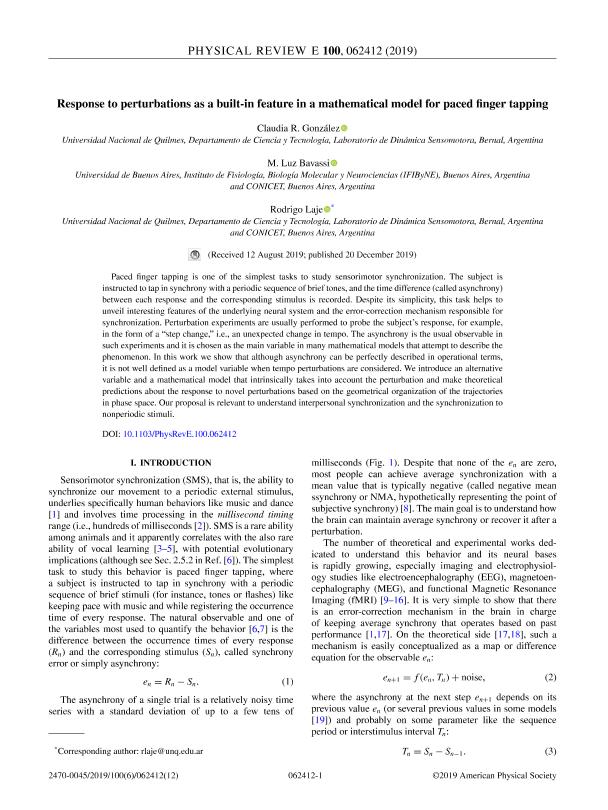Mostrar el registro sencillo del ítem
dc.contributor.author
González, Claudia Roxana

dc.contributor.author
Bavassi, Mariana Luz

dc.contributor.author
Laje, Rodrigo

dc.date.available
2022-10-27T11:36:14Z
dc.date.issued
2019-12
dc.identifier.citation
González, Claudia Roxana; Bavassi, Mariana Luz; Laje, Rodrigo; Response to perturbations as a built-in feature in a mathematical model for paced finger tapping; American Physical Society; Physical Review E; 100; 6; 12-2019; 62412-62412
dc.identifier.issn
2470-0045
dc.identifier.uri
http://hdl.handle.net/11336/175115
dc.description.abstract
Paced finger tapping is one of the simplest tasks to study sensorimotor synchronization. The subject is instructed to tap in synchrony with a periodic sequence of brief tones, and the time difference (called asynchrony) between each response and the corresponding stimulus is recorded. Despite its simplicity, this task helps to unveil interesting features of the underlying neural system and the error-correction mechanism responsible for synchronization. Perturbation experiments are usually performed to probe the subject´s response, for example, in the form of a step change, i.e., an unexpected change in tempo. The asynchrony is the usual observable in such experiments and it is chosen as the main variable in many mathematical models that attempt to describe the phenomenon. In this work we show that although asynchrony can be perfectly described in operational terms, it is not well defined as a model variable when tempo perturbations are considered. We introduce an alternative variable and a mathematical model that intrinsically takes into account the perturbation and make theoretical predictions about the response to novel perturbations based on the geometrical organization of the trajectories in phase space. Our proposal is relevant to understand interpersonal synchronization and the synchronization to nonperiodic stimuli.
dc.format
application/pdf
dc.language.iso
eng
dc.publisher
American Physical Society

dc.rights
info:eu-repo/semantics/openAccess
dc.rights.uri
https://creativecommons.org/licenses/by-nc-sa/2.5/ar/
dc.subject
NEUROSCIENCE
dc.subject
SENSORIMOTOR SYNCHRONIZATION
dc.subject
DYNAMICAL SYSTEMS
dc.subject
TIME SERIES ANALYSIS
dc.subject.classification
Otras Ciencias Físicas

dc.subject.classification
Ciencias Físicas

dc.subject.classification
CIENCIAS NATURALES Y EXACTAS

dc.subject.classification
Biología

dc.subject.classification
Ciencias Biológicas

dc.subject.classification
CIENCIAS NATURALES Y EXACTAS

dc.title
Response to perturbations as a built-in feature in a mathematical model for paced finger tapping
dc.type
info:eu-repo/semantics/article
dc.type
info:ar-repo/semantics/artículo
dc.type
info:eu-repo/semantics/publishedVersion
dc.date.updated
2022-10-27T10:24:10Z
dc.journal.volume
100
dc.journal.number
6
dc.journal.pagination
62412-62412
dc.journal.pais
Estados Unidos

dc.description.fil
Fil: González, Claudia Roxana. Universidad Nacional de Quilmes. Departamento de Ciencia y Tecnologia. Laboratorio de Dinamica Sensomotora.; Argentina
dc.description.fil
Fil: Bavassi, Mariana Luz. Consejo Nacional de Investigaciones Científicas y Técnicas. Oficina de Coordinación Administrativa Ciudad Universitaria. Instituto de Fisiología, Biología Molecular y Neurociencias. Universidad de Buenos Aires. Facultad de Ciencias Exactas y Naturales. Instituto de Fisiología, Biología Molecular y Neurociencias; Argentina
dc.description.fil
Fil: Laje, Rodrigo. Consejo Nacional de Investigaciones Científicas y Técnicas; Argentina. Universidad Nacional de Quilmes. Departamento de Ciencia y Tecnologia. Laboratorio de Dinamica Sensomotora.; Argentina
dc.journal.title
Physical Review E
dc.relation.alternativeid
info:eu-repo/semantics/altIdentifier/url/https://link.aps.org/doi/10.1103/PhysRevE.100.062412
dc.relation.alternativeid
info:eu-repo/semantics/altIdentifier/doi/http://dx.doi.org/10.1103/PhysRevE.100.062412
Archivos asociados
